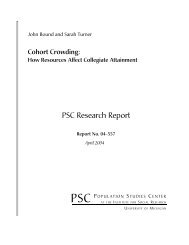Population Ageing and the Well-Being of Older Persons in Thailand ...
Population Ageing and the Well-Being of Older Persons in Thailand ...
Population Ageing and the Well-Being of Older Persons in Thailand ...
You also want an ePaper? Increase the reach of your titles
YUMPU automatically turns print PDFs into web optimized ePapers that Google loves.
Section 2: The Demography <strong>of</strong> <strong>Age<strong>in</strong>g</strong><br />
old persons than are urban areas while <strong>the</strong> latter tend<br />
to have higher proportions <strong>of</strong> work<strong>in</strong>g age adults<br />
with<strong>in</strong> <strong>the</strong> population.<br />
Table 2.4 provides both rural-urban <strong>and</strong> regional<br />
estimates for <strong>the</strong> year 2005 <strong>of</strong> measures related to<br />
age<strong>in</strong>g based on <strong>the</strong> latest Survey <strong>of</strong> <strong>Population</strong> Change<br />
conducted by <strong>the</strong> National Statistical Office (2005).<br />
In Thail<strong>and</strong> <strong>the</strong> urban population is def<strong>in</strong>ed as<br />
persons liv<strong>in</strong>g with<strong>in</strong> <strong>of</strong>ficially designated municipal<br />
areas (tetsabaan) while <strong>the</strong> rural population refers to<br />
persons who live outside municipal areas. Bangkok,<br />
by far <strong>the</strong> largest city <strong>in</strong> Thail<strong>and</strong>, is shown as a<br />
separate category dist<strong>in</strong>guished from prov<strong>in</strong>cial urban<br />
areas. Rural-urban differences <strong>in</strong> age structure <strong>in</strong><br />
Thail<strong>and</strong> conform to <strong>the</strong> general pattern described<br />
above. The proportion <strong>of</strong> <strong>the</strong> population under age<br />
15 is highest <strong>in</strong> <strong>the</strong> rural areas <strong>and</strong> lowest <strong>in</strong> Bangkok.<br />
This <strong>in</strong> part reflects higher rural than urban fertility<br />
levels although it is also <strong>in</strong>fluenced by <strong>the</strong> fact that<br />
some young children <strong>of</strong> adult migrants to urban areas<br />
are cared for by <strong>the</strong>ir rural gr<strong>and</strong>parents. Likewise,<br />
<strong>the</strong> share <strong>of</strong> <strong>the</strong> population age 60 <strong>and</strong> over is also<br />
highest <strong>in</strong> rural areas <strong>and</strong> lowest <strong>in</strong> Bangkok<br />
reflect<strong>in</strong>g <strong>the</strong> fact that migrants are concentrated <strong>in</strong><br />
work<strong>in</strong>g ages. Thus while <strong>the</strong> work<strong>in</strong>g age group<br />
15-59 represents less than two thirds <strong>of</strong> <strong>the</strong> rural<br />
population, <strong>the</strong>y constitute almost 70 per cent <strong>of</strong> <strong>the</strong><br />
prov<strong>in</strong>cial urban population <strong>and</strong> three-fourths <strong>of</strong> <strong>the</strong><br />
Bangkok population. However, because rural-urban<br />
differences <strong>in</strong> <strong>the</strong> proportions <strong>of</strong> both young <strong>and</strong> old<br />
persons are <strong>in</strong> <strong>the</strong> same direction, rural or urban<br />
differences <strong>in</strong> <strong>the</strong> median age <strong>and</strong> <strong>in</strong> <strong>the</strong> ratio <strong>of</strong> old<br />
to young persons as measured by <strong>the</strong> age<strong>in</strong>g <strong>in</strong>dex are<br />
modest.<br />
11















